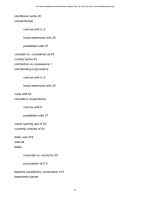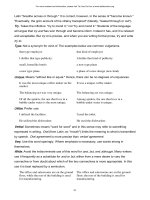Formation of plurals part II
Bạn đang xem bản rút gọn của tài liệu. Xem và tải ngay bản đầy đủ của tài liệu tại đây (13.23 KB, 1 trang )
Formation of plurals – Part II
Some nouns have identical singular and plural forms. Examples are:
swine, sheep, deer, cod, salmon, aircraft,
spacecraft, series, species etc.
The following nouns are always used in the singular form after numerals: pair, dozen, score, gross, hundred and
thousand
I bought
three dozen
mangoes. (NOT I bought three dozens mangoes.)
The music player cost me
two hundred
dollars.
He weighs above
nine stone.
Note that the plural of
fish
is fish or fishes. In modern English, fishes is used to talk about different kinds of fish.
Some nouns are used only in the plural. Examples are: bellows, scissors, tongs, spectacles, trousers, drawers,
jeans, breeches, tights, shorts etc.
A number of nouns ending in
-s
are in fact singular. Examples are: mathematics, physics, electronics, news,
measles, mumps, rickets, billiards, innings etc.
Mathematics is
his favorite subject.
No
news is
good news.
West Indies won by
an innings
and three runs.
Measles is
highly contagious.
A few collective nouns, though singular in form, are always used as plurals. Examples are: cattle, poultry, people,
gentry etc.
These poultry are
mine. (NOT This poultry is mine. )
Vermin destroy
property and spread disease.
Who
are these people?
The following nouns are always used in the singular. Examples are: luggage, news, advice, information, news,
furniture, scenery etc.
Kashmir is known for its scenery. (NOT Kashmir is known for its sceneries.)
We have received no information. (NOT …no informations)
We need to buy some furniture. (NOT …some furnitures.)
Be first to know when grammar rules change! Sign up to our newsletter here: englishgrammar.org (It's free)
Powered by TCPDF (www.tcpdf.org)









